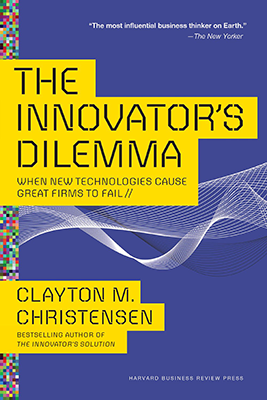The Innovator’s Dilemma
“The Innovator’s Dilemma” by Clayton M. Christensen is a seminal book that explores why successful companies often fail to innovate and adapt to disruptive technologies. Here’s a summary:
- Disruptive Innovation vs. Sustaining Innovation: Christensen distinguishes between two types of innovation: sustaining innovation and disruptive innovation. Sustaining innovation involves making incremental improvements to existing products or services to meet the needs of existing customers. Disruptive innovation, on the other hand, involves creating new products or services that initially appeal to niche markets or underserved customers but eventually disrupt the existing market and displace established competitors.
- The Dilemma: The “innovator’s dilemma” refers to the challenge that successful companies face when disruptive technologies emerge. These companies are often focused on serving their existing customers and maximizing short-term profits, which makes it difficult for them to invest in and pursue disruptive innovations that may cannibalize their existing business.
- The Cycle of Disruption: Christensen describes how disruptive innovations typically follow a predictable cycle. They start by entering the market at the low end or serving niche markets that are overlooked by established competitors. Over time, they improve in performance and quality until they eventually surpass existing products or services and disrupt the market.
- Why Companies Fail: Christensen explores why successful companies often fail to respond effectively to disruptive innovations. He identifies several factors, including:
– The tendency to focus on existing customers and markets, rather than exploring new opportunities.
– The reliance on existing business models and processes that are ill-suited for disruptive innovations.
– The fear of cannibalizing existing products or services, which leads companies to ignore or dismiss disruptive threats.
- Strategies for Success: Christensen offers strategies for companies to overcome the innovator’s dilemma and thrive in the face of disruptive technologies. This includes:
– Creating separate divisions or subsidiaries to pursue disruptive innovations without being constrained by existing business models.
– Fostering a culture of experimentation and innovation within the organization.
– Building flexibility and agility into the organization to adapt to changing market conditions.
- Case Studies: Throughout the book, Christensen provides numerous case studies and examples of companies that succeeded or failed in responding to disruptive innovations. These examples illustrate the principles and concepts discussed in the book and provide valuable insights for readers.
Overall, “The Innovator’s Dilemma” offers a compelling explanation of why successful companies often fail to innovate and adapt to disruptive technologies. It provides valuable lessons for both established companies and entrepreneurs seeking to navigate the challenges of innovation and disruption.

